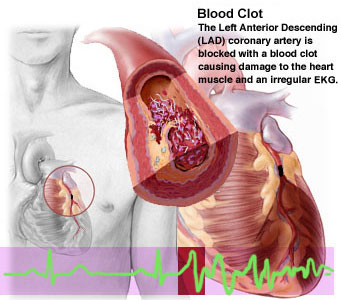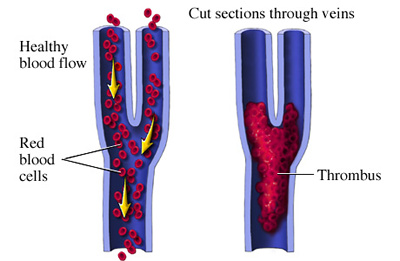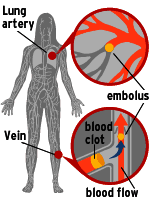|
|
Indications
Hemostasis is the ability of the body to control blood flow
after vascular injury. It is a natural process that allows blood to
thicken and form a clot to stop bleeding. Eventually, the clot helps
form a protective scab over the healing wound.Without this protective
mechanism, people would bleed to death from even minor cuts.
Sometimes, however, blood clots can form even though a person
has not been wounded in any way. Under certain conditions, a clot can
form in an artery, which could block the blood flow and cause a heart
attack or a stroke. A clot could also form in one of the heart's chambers,
travel through the blood stream and lodge itself in an organ or artery,
cutting of blood supply from that point and thus causing an embolism.

|

|
Blood clots usually form when blood flow becomes
sluggish, as when there is roughness or scar tissue along the interior walls
of a blood vessel that slows blood flow. Some underlying conditions that
could contribute to the formation of blood clots include :
- Atherosclerosis
- Heart attack
- Trauma to a blood vessel due to accident or
medical procedure
- Hypertension
- Atrial fibrillation
- Congestive heart failure
- Valvular heart disease
In addition, there are a number of risk factors that
can increase the chances of developing a blood clot. These include
:
- Smoking
- Obesity
- Prolonged lack of exercise
- Genetics
- Advanced age
- Oral contraceptive use
Oral anticoagulants such as warfarin are specially indicated
for treatment of blood clots resulting from the following :
Deep vein thrombosis (DVT) and its extension
: this is the formation of an obstructing blood clot in the deep veins
embedded in the muscles, usually in the lower leg and sometimes in the
lower abdomen or groin. It causes permanent damage to the vein. There
is also a high risk of either the whole or part of the clot breaking off
, travelling through the bloodstream and getting lodged in one of the arteries
of the lungs, causing a possibly fatal pulmonary embolism.
Pulmonary embolism : An embolism occurs when
a clump of material such as a piece of plaque or blood clot travels
through the blood stream and becomes lodged in a blood vessel. Pulmonary
embolism is a commonly occurring type of embolism, and oral anticoagulants
like warfarin are used in their prophylaxis and treatment.
Atrial Fibrillation (AF) : this is a rapid, irregular
heart rhythm (arrythmia) caused by abnormal electrical signals from
the upper chambers of the heart (atria). The normal heart rate
is 60-100 beats per minute. AF is marked by a rapid heart rate of 100-175
beats per minute. Instead of contracting normally, the atria quiver.There
is a chance that blood may pool in the atria, which can lead to the formation
of blood clots. These can break off and cause emboli or stroke.
Valvular heart disease and heart valve replacement
: Valvular heart disease is any dysfunction or abnormality of one or
more of the heart's four valves.Heart valves act as gates and
keep blood flowing in one direction Diseased valves which cannot be repaired
are replaced by artificial ones. Anticoagulants help prevent the body's
natural response of forming blood clots around foreign objects such as
the artificial valve. They thus prevent complications associated with
blood clots and also reduce risks of valve malfunction.
Post Myocardial Infarction (MI) : A heart
attack is an event that results in permanent damage or death to part
of the heart muscle. It is also known as a myocardial infarction, because
part of the heart muscle (myocardium) may literally die (infarction).
A heart attack occurs when one of the coronary arteries becomes severely
or totally blocked, usually by a blood clot, and specially when the
artery has been narrowed by fatty plaque (atherosclerosis). Following
recovery from MI, patients remain at increased risk of sustaining subsequent
thromboembolic complications, a recurrent MI, stroke or even death.
Anticoagulants such as warfarin and aspirin are generally used to reduce
such risks.
|



